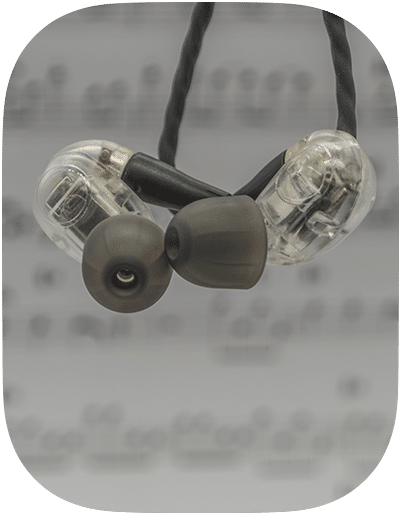In decades past, stage monitors were simply large wedges that had to provide enough sound for musicians to be able to hear themselves above all the other noise. Unfortunately, this came at a cost of hearing loss over time (especially when coupled with noise from amplifiers), and it’s not uncommon to find many elderly rock stars who have hearing loss as a result of this. Today’s monitors are thankfully much more sophisticated, and in-ear monitors are one of the best investments you can make for your musical career. At our Livingston office, we offer state-of-the-art services to musicians looking for customized monitors that provide the best possible sound at the best possible cost.
What is an In-Ear Monitor?
In-ear monitors are devices that playback your mix into your ear at a safe and adjusted level. It also allows you to customize your mix so that certain instruments or voices are louder or quieter based on what you want to hear. This is done wirelessly, and many new models also include noise-canceling technology so that you don’t experience noise bleed from the stage, meaning you get a crystal-clear sound.
Why are In-Ear Monitors Important?
As a musician, your hearing is one of the most valuable skills you have. That being said, relying on wedge monitors can expose your hearing to dangerous levels, especially over time. The reality is that exposing yourself to as little as 85 decibels for extended periods of time (even a half hour) can damage your hearing. Although your hearing can generally recover from a one-time exposure, your hearing won’t hold up if your hearing is your livelihood. Noise-induced hearing loss (NIHL) is extremely common among musicians, meaning it’s important to protect yourself.
Additionally, using simple earplugs can interfere with your ability to clearly hear yourself. These can’t selectively dampen unique sounds, meaning it can be hard to hear the noises you want to hear as well as the ones you don’t want to hear. With in-ear monitors, you can introduce your performance directly into your ear at a safe level while also blocking out stage noise for a pure and exact sound mix.
At Hearing Doctors of New Jersey, your in-ear monitors will be chosen using our H.E.A.R. Method™ Treatment Program. This means that our audiologists will carefully consider your needs and work with you to select in-ear monitors that will be most effective for you and fit properly. This high standard of care ensures that your hearing health is taken into consideration first and foremost, and your in-ear monitors will protect your hearing long-term.
Schedule an Appointment
In-ear monitors and other musician services can be an excellent way to take your performance to the next level. To learn more about your options at our Livingston office, we invite you to schedule a consultation with our team by calling or filling out our online form.

